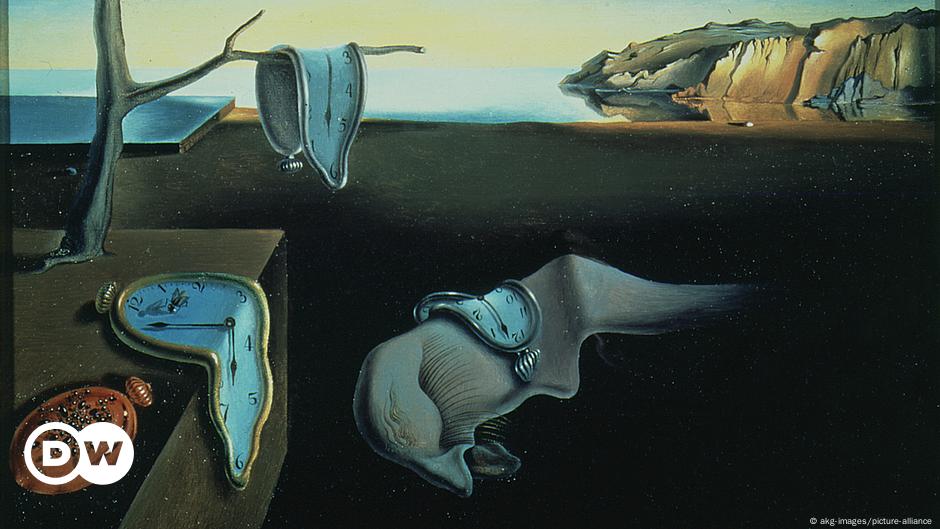
Surrealism movement turns 100 ? DW ? 10
"The Surrealist Manifesto" was published a century ago. Artists like Andre Breton and Salvador Dali aimed to create a better future. How has their legacy changed the way we see the world?
A desert landscape features a leafless tree with a melting watch draped over it, signifying the fleeting nature of time. The body of a creature resembling a dead horse lies on the ground, creating an atmosphere that is both somber and bizarre. In his iconic 1931 painting "The Persistence of Memory," Salvador Dali (1904-1989) created this dreamscape, rich in symbolism. The Spanish painter's most famous works remains an icon of the surrealism art movement, still one of the most celebrated a century after it got off the ground.
The movement got its start in Paris in the 1920s after the end of World War I in 1918. The period was known as "Les Ann?es Folles," aka the "Roaring Twenties," and the city was vibrant. The 1924 Olympics attracted athletes to the so-called City of Light, while the creative scene was booming as artists, writers, musicians and intellectuals made Paris into the cultural capital of Europe.
French writer Andre Breton published 'The Surrealist Manifesto' in 1924 Image: Heritage-Images/picture alliance
A societal shift
And then there were the surrealists who weren't satisfied with simply enjoying life's frivolities ? they wanted to change the society they felt was responsible for the atrocities of WWI.
Born out of the earlier Dada movement, surrealism was a political and artistic counter-movement which aimed to imagine a different future. Whether painters, filmmakers, writers or musicians, the followers of this new art movement rejected the bourgeois zeitgeist.
The surrealists wanted to surpass logic and rationality to unite the unconscious and conscious realms of the mind. Their philosophy drew heavily from the work of the founder of psychoanalysis, Sigmund Freud. As such, dreams, states of intoxication, repressed desires and other keys to the subconscious were seen as pivotal to freeing society from its moral shackles.
The founder is largely considered to be Andre Breton, a French writer and critic who published "The Surrealist Manifesto" in 1924. In it, he presented the new movement writing: "I believe in the future resolution of these two states, dream and reality, which are seemingly so contradictory, into a kind of absolute reality, a surreality?"
A long legacy
The surrealist movement inspired artists all over the world.
Take for example, "The treachery of images" by the Belgian surrealist artist Rene Magritte. The painting depicts a pipe, underneath which is written the stubborn text "Ceci n'est pas une pipe" ("This is not a pipe"). What at first seems puzzling is in fact accurate ? after all, we are not looking at a pipe, but rather at a picture of a pipe. Surrealism offered a new perspective.
In the 1929 black-and-white film "An Andalusian Dog," Spanish director Luis Bunuel and his friend Salvador Dali brought a surrealist work to the big screen. The plot was based on their dreams. In the prologue, a man sharpens a razor, then a cloud passes by a full moon. Immediately afterwards, a man slices through a woman's eye with the razor. Nothing about the film was meant to be rational or logical ? the title doesn't even have anything to do with the content.
Is it a pipe or isn't it? Ask Rene Magritte who made this work of art 'La trahison des images: Ceci n'est pas une pipe' Image: IAN LANGSDON/dpa/picture alliance
From drip painting to flying beds
German painter Max Ernst (1891-1976), also a surrealist, had a different approach. He painted and drew spectacular fantasy landscapes populated by imaginary figures. He developed various techniques for this, such as frottage, which involves rubbing pencil, graphite or another medium onto a sheet of paper that's been placed on top of a textured object or surface.
Later, Jackson Pollock, a pioneer of abstract expressionist movement in the US, developed his drip painting technique to splatter and paint on a horizontal surface in order to survey the work from above.
Opposites collide in many of the surrealists' works, whether via use of material or context. The fur-lined teacup by Berlin artist Meret Oppenheim (1913-1985) is one famous example.
By using twisted perspectives, or fantastical creatures, surrealist artworks often picture things detached from their usual context, depicting them in new ways and thus providing a different view of the world around us.
Some pictures are disturbing, such as Frida Kahlo's emotional 1932 self-portrait "Henry Ford Hospital." It depicts the Mexican painter (1907-1954) in a flying bed after a miscarriage.
Surrealism often depicts objects or themes out of context, such as this work by Man Ray, 'Le Violon d'Ingres' Image: FACUNDO ARRIZABALAGA/dpa/picture alliance
The Catalan artist Joan Miro (1893-1983) should also be included in the circle of surrealists, as well as Yves Tanguy (1900-1955), whose pictorial worlds are rooted in his childhood.
Not to mention the American photographer, film director, painter and artist Man Ray (1890-1976). His famous nude photograph of a woman with a violin for a body "Le Violon d'Ingres," taken in Paris in 1924, was sold two years ago for $12.4 million (?11.4 million) at Christie's auction house ? the most expensive photo ever to be sold.
And what about Andre Breton? He was one of the first to devote himself to "?criture automatique," or automatism, a method of intuitive writing or art making with which one puts images, feelings and words of the subconscious on paper. Breton described the writing process as "the dictation of thought in the absence of all control exercised by reason and outside all moral or aesthetic concerns." The goal was to involve the subconscious in the art making process as much as possible and leave out one's logical side.
Surrealists, such as German artist Max Ernst, often experimented with new techniques Image: Archives Snark/Photo12/picture alliance
Anniversary exhibitions worldwide
The surrealists rebelled against rigid norms of society. They painted, wrote and filmed against logic and pragmatism ? and for equality. They wanted to use art to instigate a social revolution. But above all, they helped revolutionize our perception, which is currently facing a new turning point as artificial intelligence and machine learning allow reality and virtuality to be intertwined almost seamlessly.
Anyone wishing to learn about the surrealist art movement today should head to Paris where the Centre Pompidou is rolling out the red carpet with a major blockbuster exhibition that will run until January 2025 and then tour Europe. The Hamburger Kunsthalle, the Lenbachhaus in Munich and many other museums around the world are also celebrating the surrealists' anniversary year.
This article was originally written in German.






